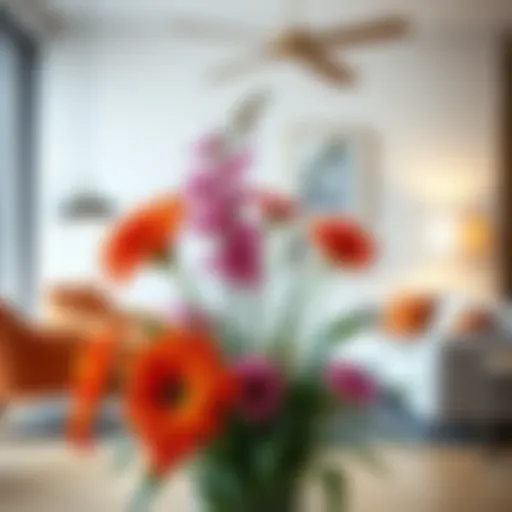Stained Glass Ceiling Lights: A Detailed Guide
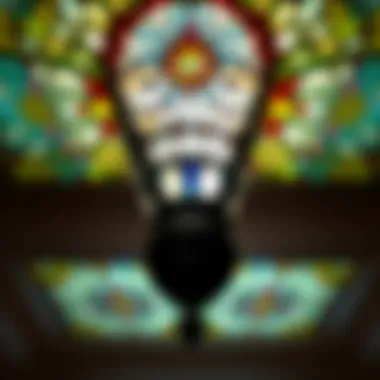

Intro
Stained glass hanging ceiling lights possess a unique blend of artistry and functionality, making them a captivating choice for illuminating both modern and traditional spaces. Their presence is not simply about providing light; it reflects numerous artistic expressions that can pull a room together, evoking certain moods or themes. As we delve further into this segment, we will explore various aspects of these enchanting fixtures. From their illustrious history to the contemporary trends shaping their design, every facet bears significance.
The evolution of stained glass lighting dates back centuries, winding through waves of artistry from simple ecclesiastical designs to elaborate motifs that grace homes today. When one selects a stained glass hanging light, they're not merely incorporating an accessory; they are choosing a piece that tells a story, enriches the atmosphere of a space, and connects them to a larger tradition of craftsmanship.
In the course of this guide, we aim to share insights that not only will enhance the aesthetic appeal of your dwelling but will also underscore the practicalities involved in selecting, maintaining, and pairing these striking pieces with your home's existing decor. So, let’s plunge deeper into the realm of design trends surrounding stained glass hanging ceiling lights.
Prologue to Stained Glass Hanging Ceiling Lights
The world of stained glass hanging ceiling lights is not just a matter of illumination; it’s an exploration of history, artistry, and ambiance. These intricate light fixtures bridge the gap between utility and aesthetics, transforming simple lighting into a captivating focal point. They allow homeowners and designers to explore personal expression—much like wearing a tailored suit compared to a generic one-size-fits-all outfit. Understanding the nuances of stained glass lighting can enhance your space while reflecting your unique style.
Definition and Purpose
Stained glass hanging ceiling lights serve a dual purpose: they illuminate a space and create an artistic statement. At their core, these light fixtures consist of colored glass pieces, often depicting intricate designs or patterns that can range from floral to abstract. These designs not only scatter a kaleidoscope of colors across walls and ceilings when illuminated but also invoke a sense of nostalgia, reminiscent of cathedrals and grand interiors from centuries past.
In essence, these lights are more than just a source of light; they are storytelling devices, capturing the essence of craftsmanship. They are metaphorically a bridge between heaven and earth, as they illuminate our everyday lives, converting mere rooms into art galleries with vibrant shades and brilliant hues. For those serious about interior design, they offer both character and a dramatic flair.
One key consideration when selecting these lights is their placement. A well-placed stained glass hanging light can become the heartbeat of a room, drawing eyes and sparking conversation. Therefore, understanding where and how to utilize them can elevate the overall aesthetic of any space, whether in a cozy dining area or a grand foyer.
Cultural and Historical Context
Stained glass's roots run deep into cultures worldwide, with history tracing back as far as antiquity. The tradition became particularly prominent during the medieval period, where churches and cathedrals adorned their interiors with magnificent stained glass windows, narrating biblical stories and the lives of saints to their congregations. Over time, this art form branched out of the ecclesiastical domain to find its place in domestic environments.
In Victorian times, as more households began to embrace ornate decor, stained glass lighting fixtures emerged as symbols of elegance and refinement. A ceiling light crafted from colored glass was not just a fixture; it was often a declaration of status, a conversation piece that highlighted social standing. The intricate craftsmanship of each piece spoke volumes, often indicating the skills of the artisan behind its creation.
With the industrial revolution, stained glass became more accessible, leading to a wider variety of designs and themes. Today, artists continue to innovate, blending traditional techniques with contemporary styles to cater to the evolving needs of homeowners and designers. The allure of stained glass remains timeless, marrying historical significance with modern sensibilities, ensuring its relevance in today’s design landscape.
As homeowners look to integrate these beautiful lighting solutions into their spaces, an understanding of their background and purpose becomes crucial. It allows for informed choices that honor the craft's heritage while celebrating its ongoing evolution.
Design Elements of Stained Glass Lighting
The beauty and uniqueness of stained glass hanging ceiling lights stem from the composition of their design elements. Each choice, from the colors of glass to the frame that holds it all together, profoundly impacts not just how the light fixture looks, but also its overall functionality in a space. This section will explore these design elements in depth, highlighting the interplay between aesthetics and practical considerations that can make or break the appeal of these decorative lights.
Color Palette and Glass Types
The color palette in stained glass lighting isn't just about choosing pretty shades; it's about creating a mood and enhancing the character of a space. From deep reds and vibrant blues to softer pastels, the colors used can evoke various feelings. For instance, warm tones like amber and gold often bring coziness, which is ideal for a dining area. In contrast, cooler colors, like turquoise or green, can create a calming effect suited for relaxation spaces, such as bedrooms.
When it comes to types of glass, the options are just as abundant. Not all stained glass is created equal. Flecked, rippled, or opalescent varies not just in visual appeal, but also in how light interacts with it. For example, opalescent glass scatters light and creates a soft glow, while textured glass can break up harsh light, preventing glare and making the setting more inviting.
Shapes and Patterns
Shapes and patterns in stained glass designs also play an instrumental role. Traditional designs often include geometric shapes or motifs inspired by nature, such as flowers or leaves. These elements can seamlessly blend with other decor, enhancing the room's overall harmony.
For a more contemporary twist, abstract shapes can modernize a space while still retaining the charm of stained glass. Architects and designers have found innovative ways to break away from the conventional, using diagonal lines or asymmetrical arrangements that draw the eye and become a conversation starter. It's much like putting a cherry on top — unique shapes can take a regular lighting feature and turn it into a centerpiece that stands out.
Frame and Fixture Design
The frame of a stained glass light fixture is not merely a functional component but a critical design element that complements the glass itself. Traditionally, many stained glass pieces use lead came, a method that not only holds the glass together but adds a vintage touch. However, modern alternatives such as copper foil offer more versatility regarding detailed designs. Copper foil allows for intricate curves and thinner lines, which can introduce more delicate visuals.
Moreover, the material of the frame can set the tone of the piece. A rustic wrought iron frame can evoke a shabby chic aesthetic, perfect for country-style homes. On the other hand, a sleek metallic finish can suit minimalist or industrial decors, bridging the gap between classical craftsmanship and modern trends.
By giving profound thought to the design elements of stained glass lighting, homeowners can find fixtures that truly enhance their spaces. When all these aspects harmonize, they can redefine the ambiance of any room, casting beautiful light patterns and creating a captivating atmosphere.
Benefits of Stained Glass Hanging Lights
Stained glass hanging lights have carved out a distinct niche in the world of interior design. They are not just about illuminating a space; they serve multiple purposes that enhance the overall atmosphere, functionality, and aesthetic appeal of various settings. In this section, we delve deeper into the myriad advantages these artistic fixtures bring to the table, focusing on aesthetic enhancement, energy efficiency, and their long-lasting nature.
Aesthetic Enhancement
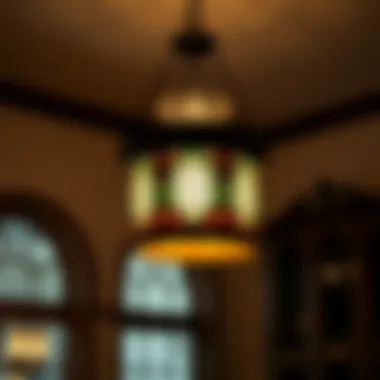

The allure of stained glass lies primarily in its visual impact. The colors and patterns are like a breath of fresh air in a room, bringing with them a touch of artistry and elegance. When you hang a stained glass light fixture, it becomes a focal point in any space, inviting admiration and curiosity.
The flicker of light through stained glass can completely transform a mundane area. Picture a dining room where a vibrant, intricately designed hanging light casts a colorful array of shadows on the walls as the sun sets. This play of colors not only enhances the room's beauty but also sets a mood. Interiors often benefit from these fixtures as they introduce unique textures and hues that change with the light.
Moreover, stained glass lights can complement various decor styles, ranging from traditional to modern, serving as a bridge between old-world charm and contemporary design. Integrating these lights into your living room or foyer can enhance the overall design ethos, fostering a warm and inviting environment.
Energy Efficiency Considerations
In today's world, where energy costs continue to climb, understanding the energy efficiency of your lighting is crucial. Stained glass hanging lights can integrate various technologies to help homeowners save on utility bills.
When designed with LED or energy-saving bulbs, these fixtures utilize less energy while still providing ample lighting. Not only do they reduce your carbon footprint, but they also lower the frequency of bulb replacements. The glass itself can act as a filter, allowing more light to spread without the need for higher wattage.
Taking an energy-efficient approach is not merely about costs; it’s also about sustainability. As more consumers gravitate towards eco-friendly products, stained glass lights that promote energy savings become increasingly attractive. Investing in such options can reflect your commitment to environmental stewardship while balancing aesthetics and function.
Durability and Longevity
Nothing lasts forever, but certain materials promise a lifespan that is impressive. Stained glass is known for its robustness; it can stand the test of time with the right care. Unlike other lighting options that may wear out or become obsolete quickly, a well-made stained glass fixture can last for decades, if not longer.
It is typically constructed from durable glass panes and strong frames, often made of metal or wood. Many stained glass pieces are further treated to resist fading and damage, ensuring that the beauty of the colors remains intact. Regular maintenance, such as cleaning and periodic inspections, can prolong the life of these fixtures significantly.
The longevity of stained glass not only speaks to its craftsmanship but also to your investment. Rather than frequently replacing lighting fixtures, stained glass can be an enduring element of your décor, offering both beauty and function for years on end.
Remember: Investing in quality stained glass hanging lights means you’re choosing fixtures that are as timeless as they are elegant. The money you save in replacements over time speaks to their value.
In summary, the benefits of stained glass hanging lights extend far beyond mere illumination. Their aesthetic appeal elevates the charm of any space, while energy efficiency and durability ensure they are a wise choice for both the environment and your wallet. Whether you’re redecorating your home or looking to add a dash of creativity to a professional setting, stained glass fixtures offer a compelling solution.
Installation Considerations
When it comes to adding stained glass hanging ceiling lights to your home, understanding the installation process is paramount. Having these exquisite pieces elegantly suspended overhead not only enhances the aesthetics of your rooms but also requires a thoughtful approach to ensure safety and functionality. Let's break down the key elements involved in the installation of these captivating fixtures and ensure you're equipped with all the information needed.
Necessary Tools and Materials
Before diving into the installation, it's crucial to gather the right tools and materials. Here’s what you’ll need:
- Ladder: A sturdy ladder is essential for reaching the ceiling safely.
- Screwdriver Set: Both flathead and Phillips screwdrivers will be necessary for assembling the light fixture and connecting wires.
- Wire cutters/strippers: These tools are used to prepare electrical wiring.
- Electrical tape: To secure wire connections and ensure safety.
- Mounting bracket: Often comes with the light fixture; it’s used to attach the light securely to the ceiling.
- Bulbs: Make sure to select the correct type and wattage for your fixture to avoid overheating.
- Voltage tester: This tool helps to ensure that the power is turned off before beginning the installation.
In addition to these essentials, having a clean workspace is vital. Lay out all your materials beforehand to avoid any unnecessary scrambling when you’re in the thick of it.
Understanding Electrical Requirements
Having a grasp on the electrical requirements is critical when dealing with any lighting installation. Before starting work on your stained glass ceiling light, it's paramount to ensure that your electrical system is up to code and capable of supporting your new addition. Here’s what you need to consider:
- Check Wattage: Confirm that the existing wiring can handle the wattage of the new fixture. Using bulbs that exceed wattage recommendations can lead to electrical fires.
- Circuit Compatibility: Ensure your circuit can support the additional load from the new lighting fixture.
- Location of Switch: Understand the location of your on/off switch and whether it needs to be relocated for convenience.
It’s wise for homeowners, particularly those unfamiliar with electrical systems, to consult a professional if there is any uncertainty.
Step-by-Step Installation Process
With your tools gathered and electrical requirements understood, you're ready to proceed with the installation. Here’s a straightforward guide to help you through the process:
- Turn Off Power: Before doing anything, ensure the power to the existing fixture is off. Use the voltage tester to confirm no current is flowing.
- Remove the Old Fixture: Carefully take down the existing light fixture, noting where and how it is connected. Take pictures if necessary to aid in re-installation.
- Install the Mounting Bracket: Attach the new mounting bracket to the ceiling based on the instructions provided with your new light. Ensure it is secured properly to support the weight of the stained glass fixture.
- Connect Wires: Strip the ends of the fixture's wires and connect them to the corresponding wires from the house. Typically, this is black to black (or red), white to white, and ground to ground. Use electrical tape to secure them tightly together.
- Attach the Fixture: Attach your stained glass fixture to the mounting bracket, making sure it is firmly held in place.
- Insert Light Bulbs: Install the appropriate light bulbs, ensuring they are suitable for use in a stained glass fixture.
- Final Check: Double-check all connections before turning the power back on. Ensure the fixture is secure and level.
- Turn on Power: Restore power and test the new fixture. Enjoy the breathtaking colors and patterns emanating from your new stained glass hanging light!
"Successful installation is not just about aesthetics; it's about safety and ensuring your beautiful light shines brightly without hazards."
Through these considerations and steps, installing stained glass hanging ceiling lights becomes a manageable task. Preparation is key, and by approaching the process systematically, you can enjoy the beauty and warmth these lights bring to your space.
Maintenance of Stained Glass Lights
Maintaining stained glass hanging lights is crucial for preserving their beauty and functionality. Just like any artwork, stained glass requires regular care to keep its colors vibrant and its frame intact. A well-maintained fixture not only enhances the aesthetics of a space but also ensures safety and longevity. Ignoring maintenance could lead to irreversible damage, eventually resulting in costly repairs or replacements. Therefore, homeowners and designers alike must understand the essential aspects of maintaining these exquisite lighting pieces.
Cleaning Techniques

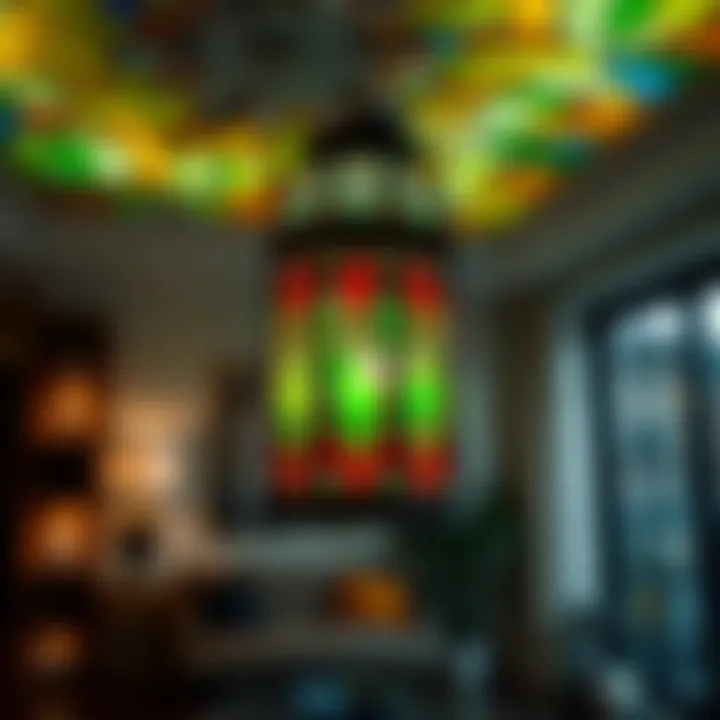
Keeping stained glass clean is fundamental to retaining its visual appeal. Over time, dust and grime can accumulate, dulling the richness of the glass. Here are a few effective cleaning techniques that can be employed:
- Soft Cloths: Use a soft, lint-free cloth, preferably microfiber, to gently wipe surfaces. Avoid anything abrasive, as this can scratch the glass.
- Mild Soapy Water: A solution made from mild soap and warm water works wonders for removing dirt. Just dip a cloth in it, wring it out, and gently clean the glass.
- Rinse and Dry: After cleaning, it’s important to rinse the glass with clean water to remove any soapy residue. Follow this up with drying using a soft cloth or allow it to air dry.
- Avoid Chemicals: Harsh chemicals or ammonia-based cleaners can be detrimental. They might strip away layers of protective coating or etch the glass.
Tip: It's best to perform cleaning on cloudy days to minimize glare and see those streaks well.
Inspecting for Damage
Routine inspections for damage are essential to maintain the integrity of stained glass lights. Here are key things to look for during your evaluation:
- Cracks and Chips: Even a small crack can worsen over time. Inspect each piece of glass thoroughly.
- Frame Condition: Check the frame for any rust, peeling paint, or structural weakness. The frame is not just aesthetic; it holds everything together.
- Leads and Solder Joints: The leads that hold the glass panes together can weaken. Make sure to inspect for any signs of breakage or corrosion.
Regularly scrutinizing stained glass lights not only supports aesthetic value but also ensures that they're safe for use. If you notice any irregularities, it may be time to consult a professional.
Professional Restoration Options
If damage is found that exceeds simple repairs, professional restoration may be your best bet. Here are some factors to consider:
- Expertise Matters: Seek out artisans who specialize in stained glass restoration. Their skills are crucial as they’ll have the right tools and knowledge to repair without causing further harm.
- Restoration Techniques: Expect procedures such as replacing broken glass pieces, re-soldering joints, or even re-framing based on the extent of damage.
- Cost Consideration: Restoration can be pricey, depending on the damage's severity. However, restoring a cherished fixture may be much more cost-effective than replacement.
In sum, understanding the maintenance of stained glass lights is key to ensuring they remain the striking centerpiece they were designed to be. With proper care, these lights can illuminate your space for years to come.
Trends in Stained Glass Lighting
In the bustling domain of interior design, stained glass hanging ceiling lights are not merely relics of the past; rather, they represent an evolving canvas that reflects contemporary aesthetics and values. Recognizing the trends in stained glass lighting is pivotal for homeowners and designers who wish to integrate these artistic fixtures into modern spaces, as it enables them to make choices that resonate with both style and functionality.
Modern Interpretations
Today's artists and designers are breathing new life into the traditional stained glass art form. This revival showcases a shift from solely classic styles to modern interpretations that incorporate abstract designs and unique motifs. Instead of the often rigid patterns associated with historical stained glass, contemporary pieces often embrace an organic flow, resulting in a design that feels alive and dynamic.
For instance, some artists mix various types of glass, playing with transparency and texture. You might encounter designs where frosted glass is layered with vibrant colors, creating a playful interplay of light and shadow. This adaptability allows stained glass to not only serve as a lighting source but as a focal point in the room. The blend of these elements illustrates how stained glass can still tell stories while fitting seamlessly into various aesthetic frameworks.
Sustainable Materials and Practices
As the world becomes increasingly aware of environmental issues, sustainability in design has emerged as an essential trend. In the realm of stained glass lighting, this manifests in the use of sustainable materials and ethical practices. Artists are now opting for recycled glass, which not only reduces waste but also infuses each piece with unique history and character.
This approach enhances the appeal of stained glass lights, allowing customers to feel good about their purchases. More than just a way to brighten a space, these lights can serve as conversation starters about sustainability. Furthermore, many artisans are now focusing on energy-efficient lighting solutions, incorporating LED technology into their designs. This means that while you enjoy the beauty of stained glass, you’re also contributing to energy conservation, a win-win scenario.
Integration in Contemporary Interiors
Stained glass lighting is finding its niche in contemporary interiors, marking a delightful juxtaposition against minimalist designs. It's often said that opposites attract, and this holds true for the evolving interior designs today. The intricate beauty of stained glass can soften the rigor of modern architecture, adding depth and character.
In practical terms, stained glass lights can complement various color palettes, ranging from muted earth tones to vibrant, modern hues. They are being seen more often in kitchens, dining rooms, and even offices, where they provide both illumination and a touch of artistry.
- Living Spaces: The soft glow of stained glass can create an inviting atmosphere, contrasting beautifully against sleek lines and neutral colors.
- Commercial Spaces: Restaurants and cafes use stained glass to give a warm, welcoming vibe, making the place feel unique and memorable.
Sourcing Stained Glass Hanging Lights
Sourcing stained glass hanging lights is not just about finding a decorative piece; it’s about a commitment to quality, artistry, and personal expression in home design. Each fixture holds the potential to reflect not only light but also the unique story of its creation and the environment in which it will reside. In this section, we will uncover the significant aspects of sourcing stained glass lights and distinguish between working with local artisans and mass-produced options, alongside exploring the myriad online avenues available to today's savvy consumer.
Local Artisans vs. Mass-Produced Options
When deciding where to purchase your stained glass lighting, the choice between local artisans and mass-produced options can significantly influence not just the quality of your fixture, but also its uniqueness and the story behind it.
Local Artisans
Supporting local artisans can mean much more than just acquiring a light fixture. It can provide a sense of connection to a community and an appreciation for craftsmanship. Each piece from an artisan typically reflects painstaking attention to detail and might incorporate regional styles or culturally significant designs. Here are some benefits of choosing local artisans:
- Customization: Many artisans offer the chance to tailor designs and colors according to personal preference, allowing homeowners to truly make the piece their own.
- Unique Creations: Artisan pieces are often one-of-a-kind or limited edition, which means homeowners have lighting that stands out and cannot be easily replicated.
- Quality Assurance: Local artisans often use high-quality materials and time-honored techniques, ensuring durability and longevity.
However, it’s important to consider potential limitations, such as higher price points and longer wait times versus mass-produced items.
Mass-Produced Options
On the other hand, mass-produced stained glass lights appeal to those who seek affordability and convenience. Retailers like Home Depot or Lowe's provide an array of styles that can cater to various tastes and budgets. Yet, while they might lack the personal touch of an artisan creation, they do hold certain advantages:
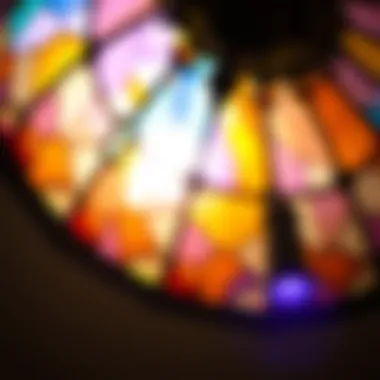
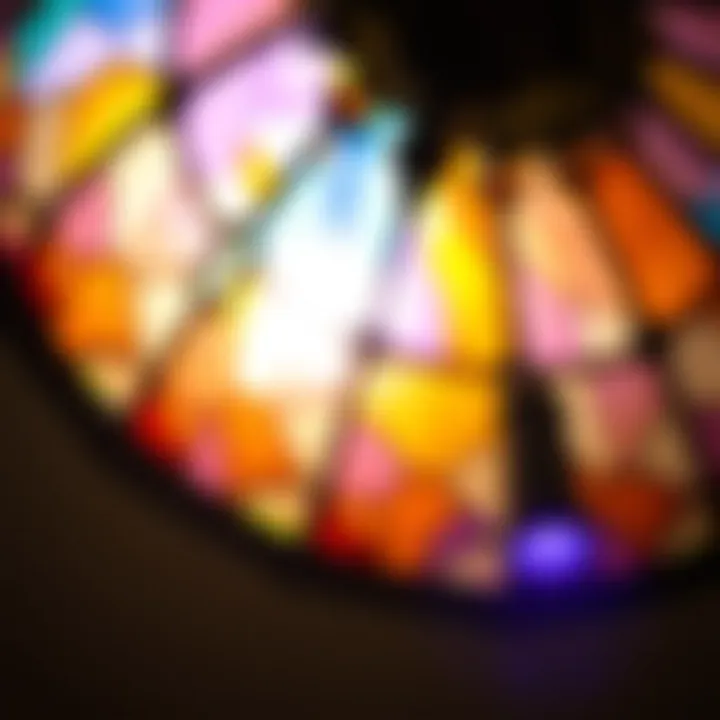
- Affordability: Mass-production typically results in lower prices due to economies of scale, making it easier to find fixtures that soft on the wallet.
- Immediate Availability: Unlike waiting for an artisan to create a piece, mass-manufactured lights can be purchased and delivered quickly.
- Variety: Large retailers often carry extensive catalogs, making it easier to find something that no only fits your style but also can match existing decor.
In the end, the decision boils down to what aligns with your values and vision for your space. Whether you opt for the personal touch of artisanship or the efficiency of mass production, ultimately, it's about finding that perfect piece that meets your needs.
Online Retailers and Marketplaces
In today's digital age, the world of stained glass lighting has expanded beyond traditional stores. Online platforms provide an abundance of options, connecting homeowners with a vast array of sellers across the globe. Here, we'll explore the various avenues available through online retailers and marketplaces, as well as some insights on making informed choices.
E-commerce Platforms
Websites like Amazon or Wayfair offer a straightforward shopping experience, packed with customer reviews and ratings which can be invaluable when evaluating quality. Additionally, these platforms are equipped with search filters to help narrow down your choices to perfect matches based on style, price, and even material.
- Pros: Easy access to diverse range, user-generated feedback, and competitive pricing.
- Cons: Some may find it challenging to assess the actual quality from photos and descriptions alone.
Artisan Marketplaces
Platforms like Etsy or ArtFire specifically cater to sellers of handmade goods, allowing customers to support individual artisans without the need to step foot in a local shop. These sites often showcase the stories and background of creators, providing insight into the artistry behind their work.
- Pros: Ability to purchase unique handmade items directly from creators, often with customization options.
- Cons: Variability in production times and shipping cost can be a factor to consider.
In summary, be sure to conduct careful research and consider the reviews, seller ratings, and return policies while navigating the online marketplace for stained glass lighting. This approach helps ensure that you not only find a fixture that resonates with your style but also one that meets the functional requirements of your space.
Ultimately, sourcing stained glass hanging lights can be a journey of discovery—whether through artisan craftsmanship or online shopping. The decision hinges on individual preferences, but with both traditional and modern avenues available, there are plenty of options to illuminate your home in your unique style.
Purchasing stained glass lighting is not merely a functional choice but a decision that reflects art, culture, and personal expression.
For more information on artisan shops and handcrafted lighting, check out Etsy and ArtFire. Explore traditional craftsmanship at Wikipedia.
Stained Glass Lighting in Different Spaces
Stained glass hanging lights are more than just functional fixtures; they play a pivotal role in setting the ambiance of various rooms in your home. The beauty of stained glass lies not only in its intricate designs but also in how it interacts with light, transforming even the most mundane environments into vibrant displays. Understanding where and how to incorporate these luminous artworks can elevate your interior design game.
Living Rooms and Foyers
In living rooms and foyers, stained glass lighting can become a conversation starter or a focal point. When you hang one of these artistic fixtures, sunlight streaming through the glass creates a dance of colors on walls and floors, giving life to the space. This not only adds a unique aesthetic but also provides soft, diffused lighting that is much more inviting than harsher, standard fixtures.
- Consider Size and Scale: Depending on your space, you want a piece that complements rather than overwhelms. A large stained glass chandelier can anchor a grand entryway, while a smaller pendant can create a cozy nook.
- Choosing the Right Color Palette: Consider the existing color scheme of your room. A stained glass light with deep jewel tones can evoke an elegant, classic feel, whereas lighter, pastel shades may uplift a modern, airy living room.
Dining Areas
In dining areas, stained glass lighting serves a dual purpose: it provides necessary illumination and enhances the overall dining experience. When it comes to meals, ambiance matters significantly. A well-placed stained glass fixture can turn a simple dinner into an enchanting experience.
- Height Matters: When installing over a dining table, ensure the light hangs at an ideal height. You want it low enough to illuminate the table but high enough not to obstruct views.
- Complimenting Table Settings: Think about how your light fixture complements your dining décor. For instance, a beautifully crafted stained glass pendant could match a vintage wooden table or an elegant metal base, filling the space with character while diners feast.
Master Bedrooms and Home Offices
In more intimate settings like master bedrooms and home offices, stained glass lighting can contribute to a serene and focused atmosphere. The softer light produced by these fixtures is ideal for creating a space where one can unwind or concentrate—perfect for reading or working.
- Mood-Setting: Choose pieces with warm colors to promote relaxation. Subtle tones can be quite soothing, helping to carve out a personal retreat within your home.
- Functional Yet Artistic: Standing or wall-mounted stained glass lamps can enhance desk spaces without taking up valuable table real estate. Their inherent artistry means they can serve as interesting accents that deepen the character of the room.
Stained glass lighting possess an undeniable charm, applicable in any area of the home. Their ability to blend art with function makes them an invaluable addition to living spaces. By carefully considering size, color, and placement, homeowners can thoughtfully incorporate these dazzling fixtures into their design plans, creating rooms that are as functional as they are beautiful.
Ending
The significance of stained glass hanging ceiling lights transcends mere functionality; these fixtures serve as a powerful blend of art and utility. Reflecting historical craftsmanship and cultural relevance, they elevate not only the aesthetic of spaces but also contribute to personal expressions of style. By fabricating a warm atmosphere or forging focal points in rooms, these lights create an inviting ambiance that can turn a house into a home.
Recap of Key Insights
- Cultural Backdrop: Understanding the history of stained glass lends depth to its modern applications, revealing the evolution from sacred spaces to contemporary homes.
- Design Versatility: The myriad colors and intricate designs play a critical role in enhancing any room's decor. From the geometric patterns reminiscent of Art Deco to the whimsical forms found in more modern creations, stained glass has something for every taste.
- Practical Considerations: Homeowners must weigh factors like installation needs, maintenance provisions, and sourcing options when selecting these fixtures. Ensuring the longevity and energy efficiency of lighting selections can generate both comfort and savings.
- Trends and Innovations: Staying abreast of current market trends helps enthusiasts and designers make informed choices, especially with the growing emphasis on sustainability and ethical sourcing in recent years.
Ultimately, the intersection of tradition and modernity in stained glass lighting influences choices on many levels of interior design, imparting warmth and sophistication to any area.
Final Thoughts on Selection and Design
When it comes to selecting stained glass hanging ceiling lights, balance is key. One must consider the existing decor and the intended mood of a space. A vibrant, colorful fixture may serve as a stunning centerpiece in a dining room, while a more subdued design might be better suited for a tranquil bedroom environment.
- Personalization Matters: Tailoring selections to fit personal aesthetics allows for greater satisfaction. Whether opting for locally crafted pieces or exploring online marketplaces, each light can offer something unique.
- Size and Scale: Proportion plays a significant role in the effectiveness of lighting in a room. Oversized pieces can dominate a space, while delicate lights may blend too easily into the background. Finding the right balance between size and beauty is essential.
- Avoiding Common Pitfalls: It’s essential to steer clear of trends that might quickly age. Opting for pieces that resonate with timeless styles, or that can adapt with changing personal tastes, often leads to more rewarding choices.
“Good design is about making choices.”
Through exploring stained glass lights with careful consideration, one can achieve a lasting impact that goes beyond simple illumination.











